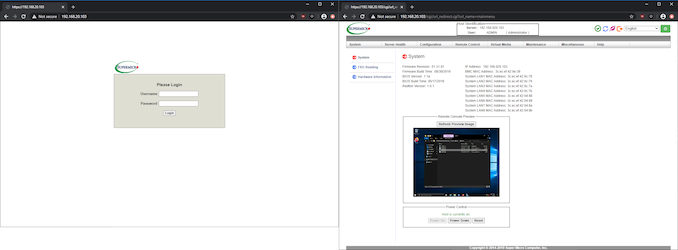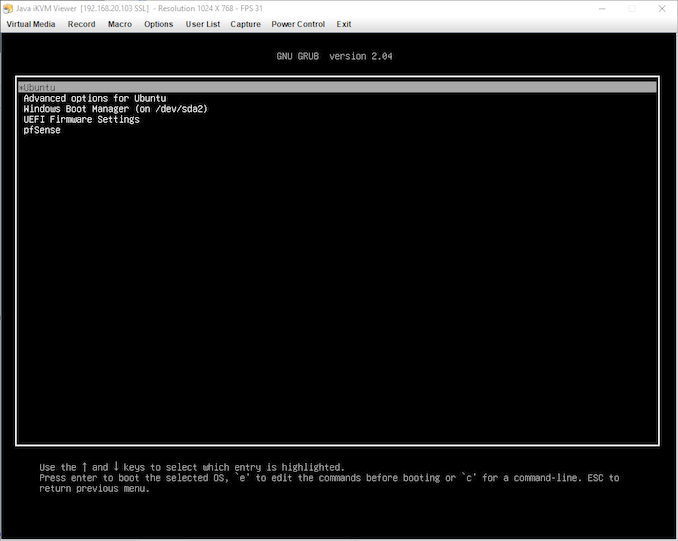Supermicro SuperServer E302-9D Review: A Fanless 10G pfSense Powerhouse
by Ganesh T S on July 28, 2020 3:00 PM EST- Posted in
- Networking
- Intel
- Supermicro
- 10GBase-T
- Xeon-D
- SFP+
- 10GbE
- ASpeed
- Skylake-D
Setup and Usage Impressions
Systems such as the SuperServer E302-9D are meant to be operated in a head-less manner (without a display attached). That said, the system does offer a VGA display output using the ASPEED AST2500 BMC SoC on board. The SoC also enables transfer of video-over-IP. Supermicro's user-friendly IPMI (Intelligent Platform Management Interface) implementation allows for users to interact with the E302-9D efficiently. A majority of Supermicro's set of IPMI features and tools cater to datacenter managers. In this section, however, we take a look at the implementation from a home-lab / developer's perspective - from setting up the system to its actual deployment and usage.
IPMI Features
After installing the build components in the system, the unit was connected to the AC mains and its IPMI LAN port was connected to the management network. By default, the IPMI LAN port is capable of obtaining an IP from the DHCP server in the network. A knowledge of the IP allows users to directly navigate to that using any modern web browser. Access to the interface is protected ny a login. Recently, Supermicro started configuring unique BMC passwords for their rackmount systems. For embedded systems like the E302-9D, the ADMIN / ADMIN combination continues to work.
The gallery below presents some of the options available using the HTML interface. With modern browsers, it is possible to utilize the HTML5-based iKVM (Keyboard/Video/Mouse over IP) viewer.
Supermicro also offers a GUI software application in IPMIView (reliant on the OpenJDK runtime) that can be used for, among other things, discovery of Supermicro IPMI clients in the network. An overview of the capabilities offered by IPMIView for the SuperServer E302-9D is provided in the gallery above. The console relies on a Java-based iKVM viewer.
BIOS Features
The BIOS options for the server can be configured via the iKVM interface. The video below presents a walkthrough of the available features.
The BIOS allows both UEFI and legacy boot options. It also allows the configuration of the priority sequence for the boot device within a single drive (at 5:32 in the above video). Boot overrides are also possible from within the BIOS.
Triple-Booting the E302-9D
The presence of 8 network ports (not considering the IPMI LAN port) in the system makes it a suitable candidate for use with a router / firewall distribution such as VyOS or pfSense. Developers and homelab enthusiasts have different platform preferences. In order to test out the behavior of the system across representative scenarios, we decided to set up a triple-boot configuration with Windows Server 2019 Standard x64, Ubuntu 20.04 LTS, and pfSense 2.4.5.
Three different bootable USB drives were created for the installation media for the three operating systems. The drives were physically connected to the system prior to triggering the installation via the iKVM console. It is also possible to mount images as virtual media - in this respect, the Java-based iKVM viewer works in a more user-friendly manner compared to the virtual media settings in the browser interface. Windows Server was installed first, followed by Ubuntu, and finally pfSense.
Setting up the triple-boot was fairly uneventful, with the main challenge related to modifying the grub config to allow visibility of all three OS installations. We were pleased to find that all network ports were up and running right out of the box, without the need for explicit driver installations.
























34 Comments
View All Comments
eastcoast_pete - Tuesday, July 28, 2020 - link
Thanks, interesting review! Might be (partially) my ignorance of the design process, but wouldn't it be better from a thermal perspective to use the case, especially the top part of the housing directly as heat sink? The current setup transfers the heat to the inside space of the unit and then relies on passive convection or radiation to dispose of the heat. Not surprised that it gets really toasty in there.
DanNeely - Tuesday, July 28, 2020 - link
From a thermal standpoint yes - if everything is assembled perfectly. With that design though, you'd need to screw attach the heat sink to the CPU via screws from below, and remove/reattach it from the CPU every time you open the case up. This setup allows the heatsink to be semi-permanently attached to the CPU like in a conventional install.You're also mistaken about it relying on passive heat transfer, the top of the case has some large thermal pads that will make contact with the tops of the heat sinks. (They're the white stuff on the inside of the lid in the first gallery photo; made slightly confusing by the lid being rotated 180 from the mobo.) Because of the larger contact area and lower peak heat concentration levels thermal pads are much less finicy about being pulled apart and slapped together than the TIM between a chip and the heatsink base.
Lindegren - Tuesday, July 28, 2020 - link
Could be Solved by having the CPU on the opposite side og the boardclose - Wednesday, July 29, 2020 - link
Lower power designs do that quite often. The MoBo is flipped so it faces down, the CPU is on the back side of the MoBo (top side of the system) covered by a thick, finned panel to serve as passive radiator. They probably wanted to save on designing a MoBo with the CPU on the other side.eastcoast_pete - Tuesday, July 28, 2020 - link
Appreciate the comment on the rotated case; those thermal pads looked oddly out of place. But, as Lindegren's comment pointed out, having the CPU on the opposite site of this, after all, custom MB, one could have the main heat source (SoC/CPU) facing "up", and all others facing "down".For maybe irrational reasons, I just don't like VRMs, SSDs and similar getting so toasty in an always-on piece of networking equipment.
YB1064 - Wednesday, July 29, 2020 - link
Crazy expensive price!Valantar - Wednesday, July 29, 2020 - link
I think you got tricked by the use of a shot of the motherboard with a standard server heatsink. Look at the teardown shots; this version of the motherboard is paired with a passive heat transfer block with heat pipes which connects directly to the top chassis. No convection involved inside of the chassis. Should be reasonably efficient, though of course the top of the chassis doesn't have that many or that large fins. A layer of heat pipes running across it on the inside would probably have helped.herozeros - Tuesday, July 28, 2020 - link
Neat review! I was hoping you could offer an opinion on why they elected to not include a SKU without quickassist? So many great router scenarios with some juicy 10G ports, but bottlenecks if you’re trafficing in resource intensive IPSec connections, no? Thanks!herozeros - Tuesday, July 28, 2020 - link
Me English are bad, should read “a SKU without Quickassist”GreenReaper - Tuesday, July 28, 2020 - link
The MSRP of the D-2123IT is $213. All D-2100 CPUs with QAT are >$500:https://www.servethehome.com/intel-xeon-d-2100-ser...
https://ark.intel.com/content/www/us/en/ark/produc...
And the cheapest of those has a lower all-core turbo, which might bite for consistency.
It's also the only one with just four cores. Thanks to this it's the only one that hits a 60W TDP.
Bear in mind internals are already pushing 90C, in what is presumably a reasonably cool location.
The closest (at 235% the cost) is the 8-core D-2145NT (65W, 1.9Ghz base, 2.5Ghz all-core turbo).
Sure, it *could* do more processing, but for most use-cases it won't be better and may be worse. To be sure it wasn't slower, you'd want to step up to D-2146NT; but now it's 80W (and 301% the cost). And the memory is *still* slower in that case (2133 vs 2400). Basically you're looking at rack-mount, or at the very least some kind of active cooling solution - or something that's not running on Intel.
Power is a big deal here. I use a quad-core D-1521 as a CPU for a relatively large DB-driven site, and it hits ~40W of its 45W TDP. For that you get 2.7Ghz all-core, although it's theoretically 2.4-2.7Ghz. The D-1541 with twice the cores only gets ~60% of the performance, because it's _actually_ limited by power. So I don't doubt TDP scaling indicates a real difference in usage.
A lower CPU price also gives SuperMicro significant latitude for profit - or for a big bulk discount.